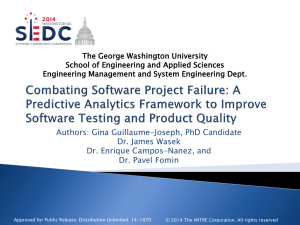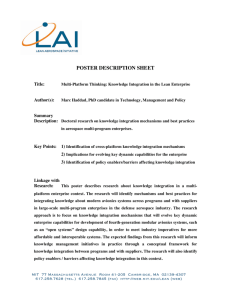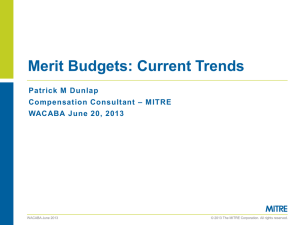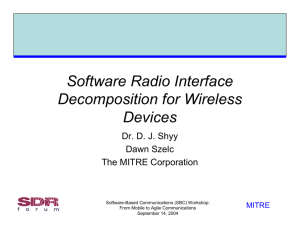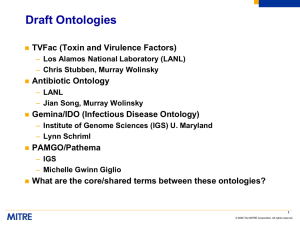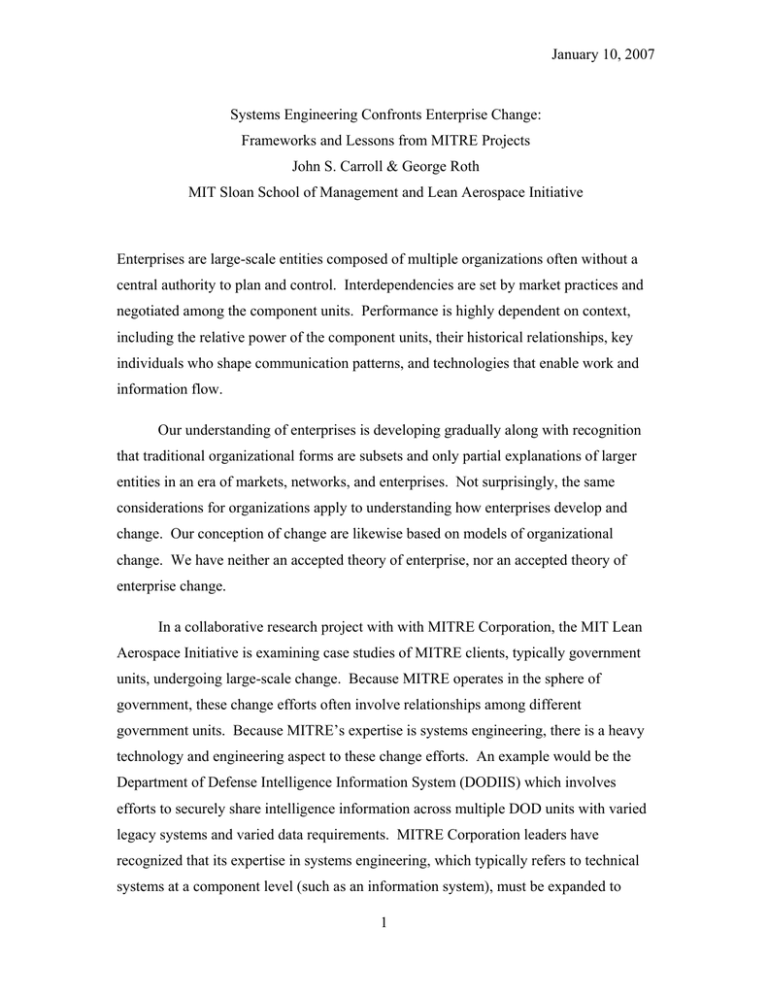
January 10, 2007
Systems Engineering Confronts Enterprise Change:
Frameworks and Lessons from MITRE Projects
John S. Carroll & George Roth
MIT Sloan School of Management and Lean Aerospace Initiative
Enterprises are large-scale entities composed of multiple organizations often without a
central authority to plan and control. Interdependencies are set by market practices and
negotiated among the component units. Performance is highly dependent on context,
including the relative power of the component units, their historical relationships, key
individuals who shape communication patterns, and technologies that enable work and
information flow.
Our understanding of enterprises is developing gradually along with recognition
that traditional organizational forms are subsets and only partial explanations of larger
entities in an era of markets, networks, and enterprises. Not surprisingly, the same
considerations for organizations apply to understanding how enterprises develop and
change. Our conception of change are likewise based on models of organizational
change. We have neither an accepted theory of enterprise, nor an accepted theory of
enterprise change.
In a collaborative research project with with MITRE Corporation, the MIT Lean
Aerospace Initiative is examining case studies of MITRE clients, typically government
units, undergoing large-scale change. Because MITRE operates in the sphere of
government, these change efforts often involve relationships among different
government units. Because MITRE’s expertise is systems engineering, there is a heavy
technology and engineering aspect to these change efforts. An example would be the
Department of Defense Intelligence Information System (DODIIS) which involves
efforts to securely share intelligence information across multiple DOD units with varied
legacy systems and varied data requirements. MITRE Corporation leaders have
recognized that its expertise in systems engineering, which typically refers to technical
systems at a component level (such as an information system), must be expanded to
1
January 10, 2007
include the social, political, organizational, and financial context around such systems.
In short, systems engineers must enlarge their skill set to become “Enterprise Systems
Engineers.” The project selects cases where MITRE personnel have encountered this
new situation in their engagements and assumes that considerable wisdom, or at least
stories of more or less success, reside in the MITRE staff.
Our collaborative MIT/MITRE team has structured the research as a series of case
studies. Although we incorporate elements of grounded theory, there are several
frameworks that we are actively using in the analysis of our case data (primarily
interview-based). In this paper, we will present these frameworks and propose them as a
nascent theory of enterprise change.
Overall, we take the change aspect of enterprises as a starting point, and therefore
in Fig. 1 outline the current state and the future state. Of course, the future state as a
plan is only one input into change and the outcome of a change process is never fully
predictable. We also divide the technical from the social-organizational aspects of
enterprises to reflect the formal technical capabilities that are contracted when
government agencies hire MITRE. The capabilities that enable change are also
separated in terms of the classical systems engineering tools that MITRE systems
engineers use to create system requirements and manage the project that implements
their design, in contrast to everything else that has to be done to integrate that design into
organizations and change the organizations and their relationships to one another in the
process.
The first set of tools is the classic Systems Engineering tools that are employed by
MITRE personnel in their engagements. In this context, where they occasion technical
change, they are necessary, but rarely sufficient, to accomplish enterprise change. In our
cases, we see multitudes of tools in use, with statements about how the tools had to be
modified, amplified, or used in different ways to address enterprise issues. For example,
[look up something in the cases].
The second set of tools is an organizational analysis approach called the Three
Lenses, developed at the MIT Sloan School of Management (Ancona et al., 2006;
2
January 10, 2007
Carroll, 2006). The Strategic Design lens considers organizations to be rationally
designed to achieve organizational goals, whereas the Political lens views organizations
as multiple stakeholders with possibly distinct interests and sources of power. The
Cultural lens examines meaning making in organizations, including symbols, artifacts,
values, and underlying assumptions shared in subcultures or the organization as a whole.
For example, consider the case where two different system designers with two different
approaches (one that was highly formalized and comprehensive from a large company,
the other quick-and-dirty from a small, new company) were forced to combine into a
single project run by the smaller, newer organization [TBONE/TBMCS case]. The
Strategic Design lens would focus on issues around reorganizing tasks and information
flows, and aligning incentives. The Political lens would see these groups as contesting
for status and power (such as when the smaller company hired away key people from the
larger), and the Cultural lens would examine how various parties understood the
meaning of this merged project and how differences in language, values, and worldviews
could make a shared, collaborative effort that much more difficult. Together, the lenses
provide more insight into organizational dynamics.
The third set of tools is an analysis of project complexity developed by Renee
Stevens at MITRE, called the Enterprise Systems Engineering Profiler. The Profiler
looks at the nature of the design effort involved in a project and the enterprise context
around that change. It contrasts a “traditional” and well-understood system development
context of extending existing capabilities in a single, known technological system, with a
stable mission/goal in a single organization, stable relationships, and agreement among
stakeholders, with the increasing complexity of many of MITRE’s engagements that are
building fundamentally new capabilities in an evolving and not fully predictable
technological system linked to many other systems, with a fluid or even ad hoc mission
in an extended enterprise with no single hierarchical authority, and many constituencies
who distrust each other and resist change. MITRE is facing more and more projects with
elements of the latter sort, and working to address them with a thin experience base of
tacit knowledge of what has seemed to work.
3
January 10, 2007
The fourth set of tools is an analysis of enterprise change capabilities (Roth, 2006)
developed from the experiences of the Lean Aerospace Initiative in implementing lean
practices and from analyzing the literature on organizational change. Five capabilities
are proposed for enterprise change: (1) rethinking organizational boundaries – attending
to and managing the entire value chain, not simply what is within functions or inside the
corporation; (2) installing innovation sets – managing change as total system change,
including internal restructuring, boundary management, and process improvement; (3)
pushing and pulling change – utilizing both top-down goal-driven change and bottom-up
commitment-based continuous improvement; (4) seeking growth opportunities – a focus
on growth at individual, organizational, and business enlargement levels; and (5)
distributing leadership practices – building and enacting a system of distributed
leadership across all levels of the enterprise.
By using these frameworks together in analyzing the cases developing from
MITRE, we hope to develop a more comprehensive and integrated understanding of
enterprise change. This is a daunting task: although there is an extensive literature on
organizational change, there is no accepted simple theory of change, and even less is
known of change at the enterprise level that involves collective action and alignment of a
complex array of stakeholders and their organizations. In our opinion, it is unlikely that
any single theory can encompass this terrain, but creating a useful map with focus on key
principles and measurable variables will be a valuable contribution. As the MITRE
cases are still under development and being cleared for internal distribution within
MITRE (via conversations with the interviewees and other stakeholders at the time of
this writing), we will be presenting our latest thinking, looking across the cases for
illustrations that can be shared publicly at the Symposium.
4
January 10, 2007
Current
Technical
System
Current System
Context:
Social, Org’n, etc.
Systems Eng’r Tools
Org’n Analysis and
Change Tools
5
Future (desired)
Technical
System
Future System
Context:
Social, Org’n, etc.
January 10, 2007
Meeting the Practical Challenge of Government Enterprise Change:
Lessons from Large-Scale Systems Implementations
Proposal for 2007 Academy of Management Symposium
Symposium chair:
JoAnn Brooks
MITRE
202 Burlington Rd.
Bedford, MA 01730
Phone: 781-271-5330
jbrooks@mitre.org
Presenters:
Jon W. Beard (MITRE)
JoAnn Brooks (MITRE)
John S. Carroll (MIT/Sloan) and George Roth (MIT/Sloan)
Renee Stevens (MITRE)
Discussant:
Michael D. Cohen (University of Michigan) [invited – response pending]
Keywords:
Enterprise Change, Complexity, Government, Technology, Systems Integration
Divisions:
Organizational Communication and Information Systems (OCIS)
Organizational Development and Change (ODC)
Technology and Innovation Management (TIM)
6
January 10, 2007
Meeting the Practical Challenge of Government Enterprise Change:
Lessons from Large-Scale Systems Implementations
This symposium focuses on practical improvement efforts in situations of enterprise
change. By enterprise, we mean a large-scale set of interdependent organizations with a
common purpose, such as a supply chain organized around a systems integrator. Efforts
to shape and change such enterprises involve multiple dimensions of complexity: 1)
complexity of inter-organizational relations, politics and leadership at the focal enterprise
level; 2) complexity of design and innovation concerns at the level of technological
systems integration; and 3) evaluative complexity 1 – a term which connotes the concerns
involved in identifying what counts as “doing good” in complex situations – often with
regard to interactions between the former two dimensions, and across stakeholders with
competing interests.
The symposium features early results from a series of case-based investigations into
government enterprise change efforts, that are facing the practicalities of these interacting
complexities. Four of the efforts are US-based, the fifth is international; most are
organized around military concerns. As government enterprises, all the cases ostensibly
aim to support the common benefit, yet in each case interactions among dimensions of
complexity present fundamental challenges to understanding what “doing good” actually
means in practice.
Government Enterprise Change
Organizational change has been recognized as a worthwhile topic for some time,
characterized by a wide variety of theoretical approaches. Beer & Nohria initiated efforts
to integrate change theories of economic value and of organizational capabilities; their
published anthology (Breaking the Code of Change, HBS 2000) indicates that this work
is barely begun, and calls for longitudinal studies and sharing information across
researchers to develop understanding. In considering closely-related issues of leadership,
Heifetz (1998) argues that adaptive problems (distinguished from routine technical
1
Thanks to Joe Sussman at MIT’s Engineering Systems Division, for this term.
7
January 10, 2007
problems), require deeper consideration of values and stakeholder responsibility. A
recent special issue of Organization Science on the topic of organization design (edited
by Dunbar and Starbuck, 2006), highlights the importance of practical improvement
efforts by well-educated employees and consultants even while theorists are still trying to
sort out conceptualizations of organizational change.
Government enterprise change efforts share many of these aspects with traditional
organizational change, and also exhibit further complications unique to government
enterprises. Because government agencies are not subject to the same bottom-line
pressures as market-driven organizations, constituent organizations within a government
enterprise often rely on inertia as a key strategy for opposing externally-originated
change. Lacking a clear and effective organizational hierarchy, in the enterprises under
study, governance is often agreed to only after a long period of ad hoc efforts and
leadership changes frequently with shifts in political administrations. The resulting
context for government employees and contractors trying to carry out intended enterprise
change is like being adrift in a turbulent sea – budgets are cut, programs cancelled, and
leadership shifts at a rate precluding substantial progress in any single direction.
Systems Engineering / Systems Integration
Many of the enterprise change efforts are actually motivated directly or indirectly by the
enabling and constraining aspects of technology: Efforts to consolidate multiple
organizations into an enterprise arise out of pressures to achieve cost savings and
efficiencies through reducing duplication via networked technologies, as in the US
Department of Homeland Security. And/or enterprise change may be motivated by
government mandates to “share information” across multiple and diverse organizations
and organizational functions as within the “community” of intelligence agencies. At the
same time, inter-organizational coordination may be required because of the
interdependencies inherent in systems integration work of getting multiple complex
technologies to interoperate for a single customer such as a globally distributed military
service. The recursive influence of technology and social action, pervasive but emergent
rather than deterministic (Barley 1986; Orlikowski 1992), makes planning such technical
systems extremely difficult because it is impossible to predict the future. Also, because
8
January 10, 2007
each government enterprise is unique, developing systems for it requires custom systems
engineering and systems integration work.
Yet, as many technologists note, “technology is the easy part” in such governmental
enterprise change. It is not known beforehand exactly what is needed to accomplish
desired changes (organizationally or technologically) on such a large scale, nor is it clear
who is in charge of which aspects of a complex integration effort. Political conflicts
involving information systems are common (Feldman & March 1981) and the inherent
relational tensions of coordinating technological design across organizations (O’Sullivan
2006) are accentuated at the enterprise scale.
As a result, boundedly rational managers and technologists struggle with the
overwhelming complexity of the change effort. Individuals drastically lower their
expectations; many become frustrated and depressed. Under such circumstances,
although few people are really ill-intentioned, few are willing to sacrifice their own
interests to advance changes which are not clearly defined, which vacillate with shifts in
national politics, and which may be easily perceived as threatening in any event. The
notion of “doing good” in such a setting is more a puzzle than a guideline. At the
enterprise level, the outcome is frequently an unfortunate grid-lock of institutionalized
fiefdoms and power struggles.
Research Study
Our research is grounded in the practical efforts of technologists working to support such
change efforts in government enterprises. The symposium presents results from a
collaborative research effort of the MITRE Corporation and MIT’s Engineering Systems
Division (MIT/ESD). Our joint project on Social Contexts of Enterprise Systems
Engineering (SCESE) is one of four collaborative research efforts regarding enterprise
systems engineering (ESE) endeavors involving government agencies, 2 and highlights
perspectives of technological practitioners. The strategic importance of such engineering
projects and their perspectives on government enterprise change should not be
2
Two other projects are concerned with real options (engineering design and financial), and the fourth with
modeling and simulating dynamics of enterprises.
9
January 10, 2007
underestimated, as systems integration in particular is growing and a key vehicle for
organizing networks of production within and across the broader society (Hobday, Davies
and Prencipe 2005).
The ESE programs under study include an information system for sharing intelligence
data across multiple Department of Defense agencies; a coordinating office for designing
and developing a next generation national transportation system; and systems supporting
communication and/or command and control across multiple military services (Air Force,
Army, Marines, Navy; also international). The intent of these cases is to collect the
experience and wisdom of technologists who have been on the front lines of enterprise
change, and to analyze it within the context of the organizations literature and drawing on
approaches and insights from MIT/ESD’s Lean Aerospace Initiative (Murman et al
2002).
Symposium Presentations
The presentations in this symposium are as follows:
Jon W. Beard (MITRE) draws from the work of Rittel & Webber (1973, 1984)
and Unidata (2000) respectively, in arguing that characterizing enterprise change as a
wicked problem is an apt way to capture the inherent richness and variability encountered
in enterprise change, and that stating the problem that needs to be solved IS the problem.
He proposes that enterprise change be viewed as an on-going process in which the
journey (i.e., the process) is considered more important than specific design, for there is
no destination or end point that can be clearly defined in advance as the final goal or
target.
Renee Stevens (MITRE): will describe a diagnostic tool for analyzing
complexity and uncertainty in government enterprise technological change (called the
Enterprise Systems Profiler), and discuss how it was applied in a particular government
enterprise change effort, highlighting some the differences in how it was used across
respondents at different positions in the enterprise.
JoAnn Brooks (MITRE) will discuss NATO’s approach to explicating enterprise
capability. As a large-scale government enterprise comprised of 26 sovereign nations
10
January 10, 2007
committed to common defense, NATO is a pre-eminent example of government
enterprise undergoing change. NATO’s governance process explicitly manages
capability packages, formalized bundles of financial, technological and organizational
descriptions, through a consensual decision-making process.
John S. Carroll (MIT) and George Roth (MIT) will present frameworks and
lessons from MITRE projects as a nascent theory of enterprise change. The frameworks
include classic Systems Engineering tools, an organizational analysis approach called the
Three Lenses, developed at the MIT Sloan School of Management, and Renee Stevens’
ESE Profiler. Additionally, they include an analysis of five enterprise change
capabilities developed by Roth (2006) out of the experiences of the Lean Aerospace
Initiative in implementing lean practices and from analyzing the literature on
organizational change. Although there is no accepted simple theory of change, and even
less is known of change at the enterprise level , they propose that creating a useful map
with focus on key principles and measurable variables is a valuable contribution.
Conclusion
Assuming that pressures toward efficiency and control will continue to mandate change
in government enterprises, the key question our presentations address is: How is it
possible to reach commonality of purpose across large-scale government enterprise
change efforts? We provide insights into mechanisms used by practitioners for
identifying/establishing common language, values, logics (mental models); developing
strategic capabilities and routines, as well as constructing effective technological
infrastructure across an enterprise without stable leadership, all within contexts of
unprecedented complexity.
11
January 10, 2007
Interest to AoM / Divisions
The study of enterprises, and government enterprises in particular, is a relatively new
field; the symposium contributes both empirical data and theoretical insights into this
growing area. Our work also reflects and contributes to growing efforts in the Academy
of Management to bridge the gap between organizational and technological perspectives
as evidenced in the growing interest in virtual teams, virtual organizations, e-government,
etc. The symposium extends that trend to the enterprise level of government. The
juxtaposition is consistent with the growing convergence of organization theory and
technology studies, illustrated by Anne Miner speaking to the TIM division at AoM ’05
and the forthcoming special issue of Organization Science on technology and
organizations.
Explanations by division:
OCIS: The government enterprise change cases described in this symposium involve
technological systems engineering and systems integration on a vast scale. As in all
IT/IS development, political issues and communicating across disparate subcultures are
intrinsic aspects of the process. The symposium offers an opportunity for OCIS Division
members to enter into the larger dialog with other divisions around such issues –
considering technology and its structuring properties as an integral aspect of the larger
challenge – neither dominant at center stage, nor side-stepped altogether.
ODC: Enterprise change efforts leverage much of what is already known about
organizational development and change. Yet government enterprises differ from
traditional organizations in several ways (e.g. government vs. corporate; enterprise vs.
organizational); the symposium will therefore contribute to developing theories of
enterprise change. The combination is particularly important because in government
enterprises with unique mission(s), learning needs to occur from samples of one or fewer
(March, Sproull and Tamuz 1991).
TIM: This symposium discusses cases which stretch traditional boundaries of scale for
technology and innovation management. While “herding cats” may be a common
metaphor for managing technological innovation in organizational settings; a more
12
January 10, 2007
appropriate metaphor for the enterprise context might be “aligning tectonic plates.” Early
results of our research suggest that existing theories of technology and innovation
management may not extend to this scale. Unintended consequences of the increasingly
rapid pace of innovation require different approaches to systems integration as Hobday et
al (2006) note, and may even challenge the ability of government enterprises to carry out
their mission.
13
January 10, 2007
References
Barley, S. R. (1986). "Technology as occasion for structuring: Evidence from observation
of CT scanners and the social order of radiology departments." ASQ 31: 78-108.
Beer, M. and N. Nohria, Eds. (2000). Breaking the Code of Change. Boston, Harvard
Business School Press.
Dunbar, R. L. M. and W. H. Starbuck (2006). "Learning to design organizations and
learning from designing them." Organization Science 17(2): 171-178.
Feldman, M. and J. March (1981). "Information in organizations as signal and symbol."
Administrative Science Quarterly 26(2): 171-186.
Heifetz, R. (1998). Leadership Without Easy Answers, Belknap Press.
Hobday, M., A. Davies, et al. (2005). "Systems integration: A core capability of the
modern corporation." Industrial and Corporate Change 14(6): 1109-1143.
Lindblom, C. E. (1959). "The science of 'muddling through'." Public Administration
Review 19(2).
March, J. G., L. S. Sproull, et al. (1991). "Learning from samples of one or fewer."
Organization Science 2(1): 1-13.
Murman, E., T. Allen, et al. (2002). Lean Enterprise Value: Insights from MIT's Lean
Aerospace Initiative. New York, Palgrave.
Orlikowski, W. (1992). "The duality of technology: Rethinking the concept of technology
in organizations." Organization Science 3(3): 398-427.
O'Sullivan, A. (2006). "Why tense, unstable, and diverse relations are inherent in codesigning with suppliers: An aerospace case study." Industrial and Corporate Change
15(2): 221-250.
14
Systems Engineering Confronts
Enterprise Change: Frameworks
and Lessons from MITRE Projects
John S. Carroll, MIT Sloan School of Management and
Engineering Systems Division
George Roth, MIT Lean Aerospace Initiative
Meeting the Practical Challenge of Government
Enterprise Change: Lessons from Systems Engineering
Academy of Management, Philadelphia, May, 2007
SCESE MSR
For Internal MITRE Use. © 2007 The MITRE Corporation and MIT. All rights reserved.
Why Did MITRE and LAI Partner?
MITRE
MITRE has been providing
system engineering and
development (especially IT)
to government clients
“Unintentionally” acting as
organizational architects and
change agents with lots of
uncodified field experience
MITRE Officer Objective 2:
“strengthen our systems
engineering practice and
advance the development of
large, complex systems
engineering at the enterprise
level”
LAI
LAI has been catalyzing the
transformation of the
aerospace industry using
“lean” (Toyota) principles
The Air Force, our principal
client, has lagged behind the
prime contractors (and
behind Army and Navy!)
Attempts to study “leading
edge” Air Force practices
frustrated: lack of examples
“Aerospace” and “Air
Force” are huge enterprises
of multiple organizations; no
one in charge
2
SCESE MSR
For Internal MITRE Use. © 2007 The MITRE Corporation and MIT. All rights reserved.
Enterprise Systems Engineering Case Histories
1. Software modernization for joint battle planning
2. An information system for sharing intelligence data
across multiple defense agencies
3. A coordinating office for designing and developing
a next generation national transportation system
4. An improved communication system for warfighters
5. An integration of legacy systems for command,
control, and consultation (diplomatic policy)
Goal for our talk: Examine the case studies through
our developing frameworks of enterprise change
3
SCESE MSR
For Internal MITRE Use. © 2007 The MITRE Corporation and MIT. All rights reserved.
Five Capabilities for
Lean Enterprise Change
Rethinking
organizational boundaries
– View organization along with suppliers and customers as a value stream
– extend improvement domain to include stakeholder environment
Installing
sets of innovations
– Complementarities of change
– extend scope to consistent and coherent programs in a system of change
Pushing
and pulling change
– Set structure and process that enables virtuous learning and change
– extend the tools to sequence and integrate divergent change approaches
Seeking
growth opportunities
– Project positive vision for continual renewal
– extend the strategy to base it on fundamental growth and development
Distributing
leadership practices
– Recognize interdependent roles in a system of leadership
– extend the leadership to all levels of the enterprise
4
SCESE MSR
For Internal MITRE Use. © 2007 The MITRE Corporation and MIT. All rights reserved.
Successful Lean Enterprise Change
Rethinking
boundaries
Distributing
leadership
The system of change
~ leads to a ~
Installing
innovation sets
lean enterprise system
Seeking
growth
Pulling &
pushing change
5
SCESE MSR
For Internal MITRE Use. © 2007 The MITRE Corporation and MIT. All rights reserved.
The Three Lenses
organizations are
machines with
roles, info flows,
& incentives to
achieve goals
Strategic
Design
Lens
organizations are
contests for power
and autonomy
among interested
stakeholders
Political
Lens
organizations are
~shared mental
maps, routines,
symbols, values,
& assumptions
Cultural
Lens
MIT Sloan School Model:
Ancona, et.al (2006),
Managing for the Future
ORGANIZATION
6
SCESE MSR
For Internal MITRE Use. © 2007 The MITRE Corporation and MIT. All rights reserved.
1. Software modernization for battle planning
Improve coordination of combat planning and execution by
integrating and upgrading legacy software systems
After early small-scale success with an agile, iterative process,
small contractor given responsibility for system
Boundaries: expanded rapidly but never “rethought”
Innovation sets: an innovative, fast approach scaled up without
understanding weaknesses and complementarities
Change: pushed from generals and pulled from the warfighter
community, but resisted by acquisitions and systems
engineering communities (robustness vs. flexibility goals, etc.);
MITRE can exercise influence, but little power
Growth: a goal for the contractor but not the system
Leadership: ambivalent between top-down and bottom-up
Note: color coding refers to the 3 Lenses
7
SCESE MSR
For Internal MITRE Use. © 2007 The MITRE Corporation and MIT. All rights reserved.
2. An intelligence information system
Provide intelligence to the military command through IT
infrastructure, technology, systems, and services
From 1978 distributed development shift in 2005 to “Enterprise”
Boundaries: one Directory acquired control over separate IT
budgets and resources
Innovation sets: reorganize, re-architect, codify standards, new
capabilities, formal requirements process (“break your process”),
ongoing training and education, ongoing set of meetings &
conferences, regular personal communication by Chief Eng’r,
less effort to “MITREize” new people
Change: push change from the top; bottom with growing
concern about usefulness of current system
Growth: capabilities and flexibility for future system
Leadership: centralized IT leads, local groups follow with
decentralized development and execution
8
SCESE MSR
For Internal MITRE Use. © 2007 The MITRE Corporation and MIT. All rights reserved.
Enterprise Transformation
Cases
Installing Pushing
Rethinking innovation & pulling
boundaries
sets
change
Seeking
growth Distributing
opp’ties leadership
1
2
3
4
5
9
SCESE MSR
For Internal MITRE Use. © 2007 The MITRE Corporation and MIT. All rights reserved.
Conclusions
Systems Engineering is about more than design of new
technologies; it is about enterprise transformation
We have a lot to learn about enterprise transformation that
stretches theories of change to the breaking point: even getting
the pieces right may not result in system change!
Especially challenging in government organizations and
enterprises that mix of government and for-profit companies
Organizational processes are out of sync; change efforts keep
colliding as each organization responds
People are looking for tools and methods without considering
how context and culture affect implementation
Engineers are in a key position to facilitate change, but they
need an expanded skill set: the “soft stuff” is hard!
10
SCESE MSR
For Internal MITRE Use. © 2007 The MITRE Corporation and MIT. All rights reserved.
Extra Slides
11
SCESE MSR
For Internal MITRE Use. © 2007 The MITRE Corporation and MIT. All rights reserved.
MITRE’s World
MITRE is embedded in shifting institutional “forces” of
technological innovation and stakeholder politics
–
–
–
–
–
Standalone stovepipe systems to networks
Custom-built to commercial off-the-shelf
Weapons systems to IT
Fragmented to consolidated sponsor fiefdoms
Large system contractors to multiplicity of vendors
MITRE has always managed the technological
intricacies/contingencies of Systems for government
agencies
As the technology and the world change
– MITRE’s business is changing
– The pace of change is accelerating
12
SCESE MSR
For Internal MITRE Use. © 2007 The MITRE Corporation and MIT. All rights reserved.
Enterprise Systems Engineering Profiler
Original by R. Stevens (E300)
13
SCESE MSR
For Internal MITRE Use. © 2007 The MITRE Corporation and MIT. All rights reserved.
LAI’s Mental Model of How LAI Works
Transformations
Research Ideas &
Analysis
Education of
Leaders & Doers
Enabling
action
Building
supportive
relationships
LAI Mission
Products &
Tools
Sharing Knowledge
& Experience
Networking &
Partnering
Communication &
Coordination
14
SCESE MSR
For Internal MITRE Use. © 2007 The MITRE Corporation and MIT. All rights reserved.

